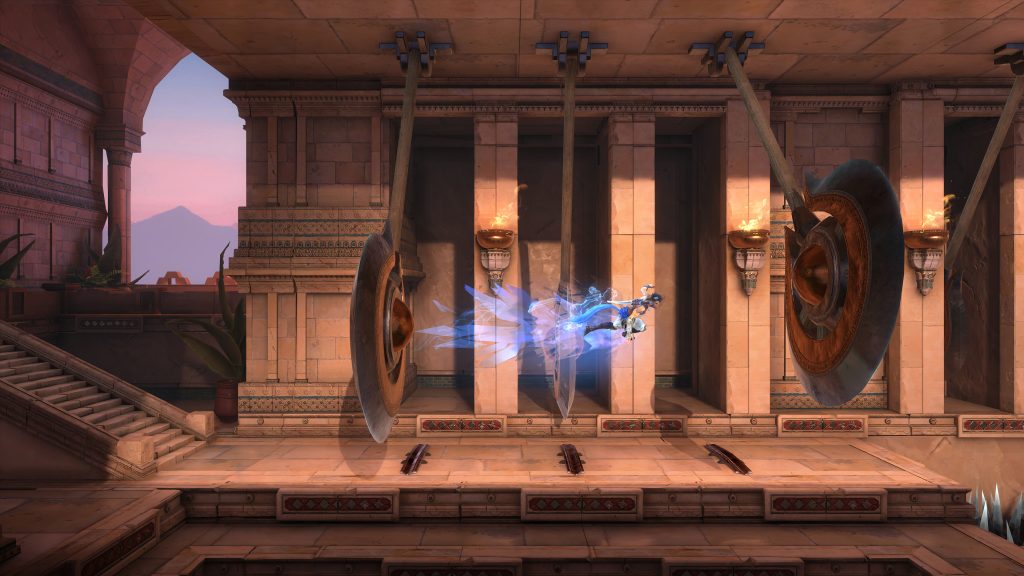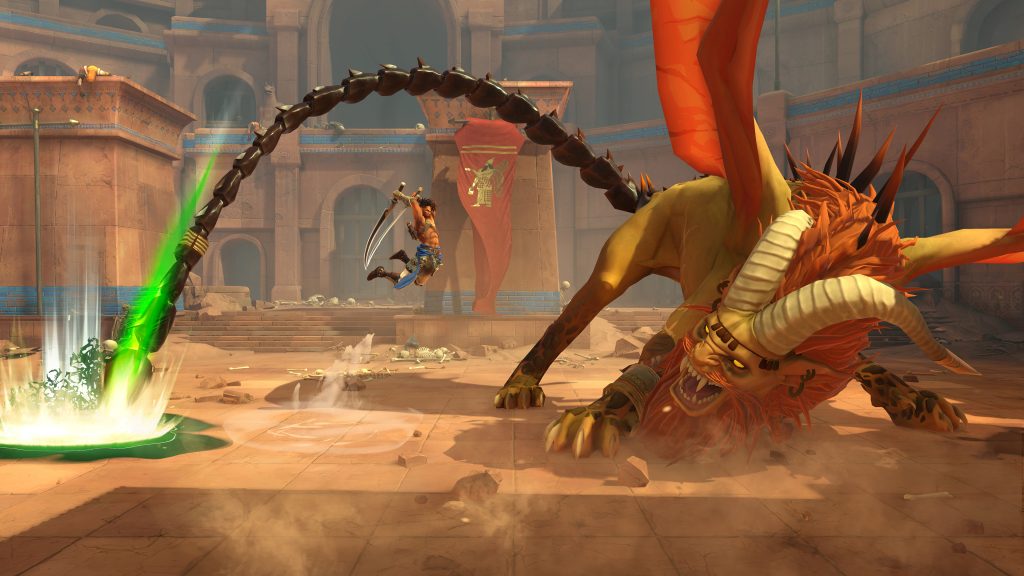Prince of Persia is one of those series that you probably have heard of but might struggle to pinpoint why. Fair enough, too, as the last mainline entry in the franchise (Forgotten Sands) came out to middling reviews way back in 2010. Fourteen years later, Ubisoft has finally decided to return to one of its oldest properties with a brand new title: Prince of Persia: The Lost Crown.
The Lost Crown is a 2D Action Platformer and essentially a complete reboot of the series. You play as Sargon, the youngest member of a group of powerful Persian warriors known as The Immortals. When Prince Ghassan is kidnapped and taken to the cursed city of Mount Qaf, Sargon and the other Immortals are sent by the Queen to rescue him.
The Lost Crown wastes no time in letting you know you’re in for a treat. While it may play in only two dimensions, the detail to be found in the backgrounds is nothing short of incredible. Screenshots don’t do this game justice. The prologue takes place during a battle against an invading army, the sky is stained blood red, arrows fly, fires burn and soldiers fight in the background.
It’s in this battle that you’re introduced to Sargon and the other Immortals. Every single one of them has such a distinct design that they could all easily be the protagonist of their own game. The Lost Crown is fully voice-acted, and it’s such a novelty to hear characters joke and bounce off each other in a game like this. This introductory mission also steps you through how the game will play.
Prince of Persia: The Lost Crown is a Metroidvania, through and through. The quickest comparison to make would be to Hollow Knight, which also has you control a sword-swinging main character. Tapping square will have Sargon attack in a combo of three, hold the button to charge an attack, x to jump, L2 to parry, you know the drill.
By dealing damage and avoiding taking it you build up your athra meter which lets you use a series of abilities that you will unlock throughout the game. These range from a charging stab attack to a whirlwind slash to conjuring a pool of healing light. Some of the higher-level abilities are truly spectacular, but saying any more would spoil things!
The variety of foes Sargon comes up against is super impressive. Every individual area of Mount Qaf has several unique enemy types, each with its own look and mechanics. This carries over into the boss fights too, which only escalate in spectacle as the game goes on. The bosses have multiple phases and several different attacks that you’ll have to contend with. On normal difficulty and as someone who plays a lot of Metroidvanias I didn’t struggle too much with the bosses, but a couple of the late-game ones had me a little nervous.
The other game I was consistently reminded of while playing The Lost Crown was Metroid Dread because damn can Sargon move. Holding R2 has him slide into a running dash which feels fantastic. The controls are snappy and responsive right out the gate, a make-or-break moment for a Metroidvania. The Dread comparisons don’t end with the movement, however.
The overall production values are absurd for a 2D sidescroller. As mentioned the game is fully voice-acted, with cutscenes that would be at home in games of a much larger scope. Mount Qaf is full of stunning environments from ancient temples to magical libraries, pitch-black catacombs, and decadent palaces, all rendered with exquisite backgrounds overflowing with detail.
As a setting, the ancient Persian city of Mount Qaf feels immediately iconic. The sense of place conveyed by this cursed city stuck outside of time, haunted by Gods and myths, strangers, and spirits, rivals the likes of Hallownest in Hollow Knight. There are plenty of surprises to uncover, whether it’s an entire series of rooms unrelated to the main story, a new side quest stemming from a peculiar encounter, or a friendly run-in with a fellow Immortal.
The story is surprisingly compelling and remains engaging throughout the twenty hours it took me to reach the credits, another difficult thing for a 2D sidescroller to achieve. The other Immortals are all doing their own thing in Mount Qaf, but occasionally drop in on Sargon to provide interesting respites between long stretches of combat and exploration. These brief conversations go a long way to making Sargon feel like a character with depth who fully participates in his own story, something Samus and her ilk are rarely able to do.
An interesting mechanic The Lost Crown introduces is memory shards, which allow you to preserve a memory (take a screenshot) and pin it to that specific location on your map. This means that whenever you come across a locked door or other obstacle that you know will only be passable with the right upgrade, you know exactly where to come back to. It’s so simple and yet not something I have personally seen in a Metroidvania before.
The soundtrack is understated but successfully captures the mood of an ancient cursed city. I would be hard-pressed to point to any one track that I would want to listen to outside of playing the game, but there is certainly a lot of music uncommon to any video game, but especially a Metroidvania.
There are a couple of things that bring the experience down. Firstly I did encounter a handful of bugs. At one point a particular sound effect looped until I reloaded the game, and there were some small visual glitches like rooms not fully loading immediately or character models flickering momentarily. Worst of all, one of the few side quests in the game completely bugged out and I was unable to complete it. All of these things will hopefully be patched in the weeks after launch, but remain a bummer nonetheless.
The other disappointing elements are more closely tied to the game design. The UI for using fast travel is an assault on the eyes. It’s the sort of menu that had me moving my selection up and down and back up again and still not knowing what was going on. Secondly, there is a special currency that you get for completing the platforming challenges found across the map.
The problem is there is only one merchant who takes that currency and he only has a handful of items for sale. This meant that a lot of the environmental puzzles, while very fun and clever, ended in deflation when I realised all I would get was one of these stupid, unspendable coins.
Finally, and perhaps most impactful, the last new area before you head to the final boss felt a little underbaked. It wasn’t bad per se, it just didn’t stand up to the rest of the amazing locales in the game and didn’t do enough to justify its inclusion, aesthetically or gameplay-wise.
Prince of Persia: The Lost Crown is fantastic, and just the burst of bright colour and fresh energy the series needs. Gorgeous visuals, responsive combat and platforming, a heartfelt narrative, and a setting that holds its own among the greats. A few bugs and a slight misstep right before the finish line bring my overall estimation down a little, but only a little. Sargon just might have rescued the Prince of Persia after all.
Rating: 8.5/10
Prince of Persia: The Lost Crown was reviewed on PS5 with a code provided by Ubisoft.






